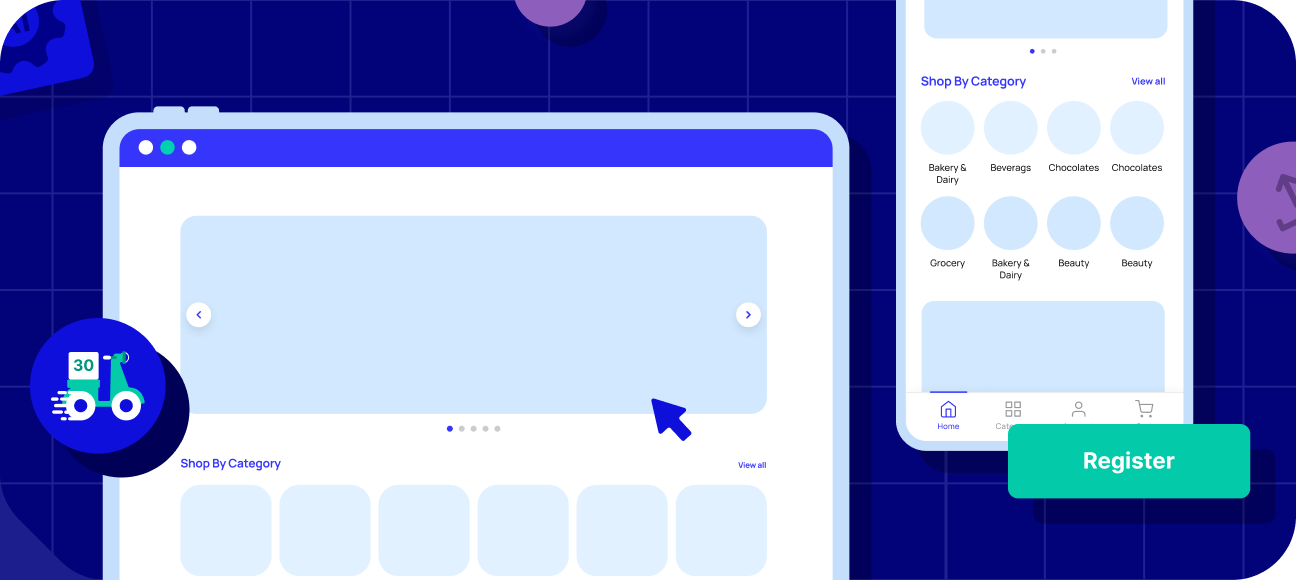Solutions for every business need
Growth comes in all shapes and sizes. Whether it’s smoother operations, sharper insights, higher revenue—or all of the above—we’ve got you covered

Warehouse management made simple
Gain full control over your inventory with smart automation, real-time tracking, and efficient workflows—ensuring your stock moves smoothly, every time

Launch hyperlocal commerce instantly
Set up and scale your hyper-local e-commerce with easy tools for web, orders, and delivery management—bringing you closer to customers, faster

Delivery management made easy
Gain control over your deliveries with real-time visibility, smart automation, and seamless coordination—ensuring on-time arrivals, every time

Order management made easy
Master every order with full visibility, smart automation, and effortless control—delivering the right outcomes, every time

Speak to an expert
Explore how Fynd Commerce can improve every aspect of your business, from online to instore and beyond

Speak to an expert
Explore how Fynd WMS powers operational excellence with our solution experts

Speak to an expert
Explore how Fynd Quick powers hyperlocal businesses with our solution experts

Speak to an expert
Explore how Fynd TMS powers better deliveries with our solution experts

Speak to an expert
Explore how Fynd OMS powers seamless order management with our solution experts

Featured Blog
What an Order Execution Management System (OMS) Does for Finance, Business

Empower your business, every step of the way
Simplify operations, scale smarter, and deliver better experiences with solutions designed to grow with your business
Take your warehouse management to the next level
Experience hassle-free inventory management with Fynd WMS, designed to keep your operations efficient and accurate. Book a demo to see how Fynd WMS can boost productivity and profits for your business!
Kickstart your quick delivery website
Experience seamless hyper-local commerce with Fynd Quick—engineered to keep things running smoothly and help you reach customers in record time. Book a demo and see how Fynd Quick can drive efficiency and growth for your business!
Level up your delivery management
See how you can manage deliveries with Fynd TMS, designed to streamline operations and keep your customers delighted. Book a demo with our team and find out how Fynd TMS can boost your efficiency and bottom line!
Take your order management to the next level
Discover how effortless order management can be with Fynd OMS, built to keep things running smoothly and make your customers happy. Book a demo with our team and see how Fynd OMS can help boost your efficiency and profits!
Order Execution Management Systems are advanced platforms designed to optimize and streamline the complex process of executing financial trades. They ensure that buy and sell orders are accurately routed, processed, and completed efficiently, thereby minimizing delays and errors that could significantly impact pricing. By integrating with multiple exchanges and dealer networks, OEMS facilitates seamless trade execution across various asset classes, including stocks, bonds, and derivatives, ensuring liquidity and efficiency.
A key feature of an OEMS is its capability to handle large volumes of transactions while maintaining high speed and precision. Automated workflows combined with real-time market data empower brokers and traders to make informed decisions, resulting in competitive pricing and enhanced efficiency throughout the entire trading process. This ability to process trades quickly is crucial, where milliseconds can make a difference in execution quality.
OEMS mitigates risks associated with market volatility and system latency, ensuring that trades are executed at the best available prices. With the increasing complexity of financial markets, these systems have become indispensable tools for brokers, asset managers, and institutional investors. They not only help users remain competitive but also ensure compliance with regulatory standards while significantly improving operational performance and accuracy.
What is an Order Execution Management System
Order execution management refers to the process of completing buy or sell orders for securities like stocks and bonds. This involves routing the order from the investor through a broker to the appropriate exchange or dealer network for fulfillment. The speed and accuracy of this process are critical as they directly affect the final price an investor pays or receives. A robust execution management system minimizes latency, reduces errors, and ensures transactions are processed efficiently, helping investors maximize their profits and avoid losses due to delays or incorrect pricing.
Types of Orders
Understanding the various types of orders is essential for effective trading strategies. Market orders are designed for immediate execution at the best available price, making them ideal for investors who prioritize speed. Conversely, working orders, also known as pending orders, execute only when specific predefined conditions are met, allowing traders to focus on achieving targeted prices.
These distinctions help traders navigate market dynamics efficiently, enhancing their ability to capitalize on favorable opportunities. Below are common types of working orders that investors can utilize to optimize their trading strategies and manage risk effectively.
Market Orders
Market orders are executed immediately at the best available price, focusing on speed rather than accuracy. This type of order is ideal for investors prioritizing quick execution. However, it is susceptible to issues like latency and slippage, where the price may change between the order being placed and executed, potentially leading to unexpected costs.
Working Orders
Also referred to as pending orders, working orders are executed only when specific predefined conditions are met. These orders focus on achieving a particular price rather than the speed of execution. Investors use working orders to better manage entry and exit points in the market, ensuring they only execute trades when market conditions align with their trading strategy.
Common Types of Working Orders
Common types of working orders help traders manage risk and execute trades more effectively. Stop orders trigger a trade once a specified price is reached, while limit orders ensure trades occur at a target price or better. Stop-limit orders combine both, executing only at the set limit price. Trailing stop orders adjust dynamically with market prices, and OCO orders link two trades, canceling one when the other executes.
- Stop Orders: Trigger a buy or sell once a specified stop price is reached.
- Limit Orders: Buy or sell at a specified price or better.
- Stop-Limit Orders: Combines stop and limit orders; becomes a limit order once the stop price is reached.
- Trailing Stop Orders: Adjusts the stop price based on a set percentage or monetary amount from the market price.
- OCO Orders: Two linked orders where executing one cancels the other, used for risk management.
What Does an Order Execution System Do
An order execution system is a critical component of modern trading, designed to manage and streamline the entire lifecycle of trade execution. It encompasses various functions such as order placement, routing, and real-time execution, ensuring that trades are processed quickly and accurately.
These systems play a vital role in financial markets by optimizing trade execution, reducing latency, and providing traders with the best possible outcomes. As markets become increasingly complex and fast-paced, understanding the essential functions of an order execution system is crucial for successful trading and maximizing profitability.
Order Execution System Overview
An order execution system is a sophisticated network of technology and protocols that manage the entire lifecycle of a trade. It handles the placement, routing, and execution of trades in real time, ensuring that orders are processed quickly and efficiently. These systems are crucial for financial markets, as they optimize trade execution, reduce latency, and ensure traders get the best possible outcomes in dynamic market environments.
Order Routing
Order routing is the process of directing trade orders to the most suitable exchange or dealer network for optimal execution. This ensures that trades are placed in the most advantageous market, considering factors like price, liquidity, and speed. By choosing the best venue for execution, order routing maximizes the chances of getting the best price and fulfilling the trade quickly and efficiently.
Price Matching
Price matching ensures that trades are executed at the best available price in the market. The system scans multiple exchanges or dealer networks to find the most favorable price for the trader, whether buying or selling. Securing the optimal price helps maximize the trader's value and ensures that trades are completed most cost-effectively, enhancing overall trading efficiency.
Immediate Confirmation
Immediate confirmation ensures that traders are promptly notified once their order has been executed. This instant feedback is crucial for maintaining transparency and enabling traders to make timely decisions based on completed transactions. By providing real-time execution updates, the system enhances trust and efficiency, allowing traders to stay informed about the status of their trades and quickly adjust their strategies if needed.
Incredible Speed
Orders are executed at an astonishing speed, often within microseconds, which is significantly faster than traditional timeframes of seconds or milliseconds. This incredible speed is essential financial markets, where delays can result in missed opportunities or unfavorable prices. By processing orders in microseconds, order execution systems ensure traders can capitalize on market fluctuations swiftly and maintain a competitive edge in trading.
DXOMS Example
Our proprietary order management system, DXOMS, is designed for ultra-low latency, executing and confirming trades in less than 50 microseconds. This remarkable speed ensures that traders can react to market changes almost instantaneously, capitalizing on fleeting opportunities. With its advanced technology and efficient processing capabilities, DXOMS sets a high standard in trade execution, helping users achieve optimal performance in fast-moving financial markets.
Responsibility
Given the high volume and speed of trades, stock trading execution systems bear significant responsibility for managing trades accurately and efficiently. They must process thousands of transactions in microseconds while minimizing errors. Maintaining market integrity is crucial, as these systems ensure reliable execution for traders. By handling real-time data effectively, they mitigate risks and enhance overall performance in fast-paced financial environments, ensuring optimal outcomes.
Features Of A Good Order Execution System
A robust order execution system is essential for traders seeking to navigate complex financial markets effectively. It combines advanced technology and customizable parameters to optimize trade execution while managing risk. Key features include real-time exposure monitoring, which provides insights into client risk, and execution settings that govern how trades are placed and managed.
By incorporating essential components such as smart order routing, exposure limits, and risk management tools, a good order execution system ensures traders can respond swiftly to market changes, enhance efficiency, and safeguard their investments against potential losses.
Real-Time Exposure Monitoring
Real-time exposure monitoring is essential for effective risk management in fast-paced financial markets. By offering both automatic and manual hedging options, advanced filtering capabilities, and detailed views of currency exposures, these tools provide comprehensive insights. Additionally, broker hedging monitoring tools enhance oversight, enabling firms to manage risk more precisely and protect against market fluctuations.
- Automatic and Manual Hedging: Offers both automatic and manual hedging options to manage client exposures and overall risk effectively.
- Advanced Filtering Capabilities: Provides advanced filtering options for individual groups or accounts, enabling tailored risk management.
- Detailed Exposure Views: Displays comprehensive views of exposures at both currency and currency pair levels for better visibility.
- Broker Hedging Monitoring Tools: Includes tools to monitor broker hedging positions, enhancing oversight and risk assessment.
Execution Settings
Execution settings are critical components of an effective order execution system, enabling traders to manage risk and optimize trade execution. These settings provide customizable parameters that govern how trades are placed, routed, and managed in real-time. Below are key features that contribute to robust execution settings, ensuring traders can navigate market conditions with confidence and efficiency.
1. Execution Rules
Execution rules are customizable parameters that govern trade execution, allowing traders to define specific conditions under which orders should be placed, adjusted, or canceled based on real-time market conditions.
2. Smart Order Routing Rules
Smart order routing rules direct trade orders to the most appropriate venues, ensuring optimal execution by considering factors such as price, liquidity, and speed to maximize trading efficiency.
3. Exposure Limits
Exposure limits establish maximum thresholds for trading exposure, helping to mitigate risk by preventing excessive positions in any single asset or market. This ensures a balanced approach to risk management.
4. Speed Bump Settings
Speed bump settings introduce slight delays in order execution to reduce market impact and prevent adverse trades. This strategy helps ensure that trades are executed at more favorable prices.
5. Tiered Margining Settings
Tiered margin settings adjust margin requirements according to exposure levels, allowing for greater flexibility in risk management. This approach helps protect against potential losses during varying market conditions.
6. Margin Settings
Margin settings provide configurable parameters for effectively managing margin requirements. This flexibility allows traders to adapt their margin levels based on market conditions, enhancing risk management and trading efficiency.
7. Price Collars
Price collars are limits set on price fluctuations to manage risk during volatile market conditions. They help protect traders from significant losses by restricting extreme price movements in either direction.
8. Kill Switch
Kill switch is an emergency mechanism designed to halt trading activity when significant issues or anomalies arise. This feature helps prevent substantial losses and maintain market integrity during unforeseen circumstances.
Best Execution Management Systems (EMS)
Effective order execution management systems (EMS) are essential for traders seeking to optimize their trading strategies and enhance operational efficiency. These advanced platforms streamline the trade execution process by facilitating real-time order routing, reducing manual errors, and ensuring compliance with regulatory requirements.
The best EMS solutions offer powerful analytics, seamless integration with multiple trading venues, and robust risk management tools. This overview highlights some of the leading EMS options available, each designed to empower traders to make informed decisions and maximize their performance in increasingly complex market environments.
1. Fynd OMS
Fynd OMS is a powerful order execution management system designed for efficient multi-channel sales. It streamlines the entire order lifecycle with real-time execution capabilities, reducing manual errors and improving operational efficiency. Seamless integration with various sales platforms and shipping carriers enhances order fulfillment. Additionally, Fynd OMS offers comprehensive inventory management and robust analytics, enabling businesses to optimize their order processing and improve overall customer satisfaction.
2. Bloomberg Trade Order Management Solutions (TOMS)
TOMS provides comprehensive order management capabilities with real-time data integration and advanced analytics. Designed specifically for asset managers, it enhances trading efficiency through seamless execution and compliance with regulatory requirements. The platform offers a robust suite of tools that facilitate the entire trade lifecycle, ensuring users can manage orders effectively while gaining valuable insights into market trends and performance metrics.
3. Charles River
Charles River’s execution management system (EMS) offers a centralized platform for managing the entire investment process. It features advanced execution algorithms that enhance trading performance, real-time risk management to mitigate potential losses, and compliance monitoring to ensure regulatory adherence. This robust functionality makes it particularly suitable for institutional investors, allowing them to navigate complex markets effectively while optimizing their trading strategies and operational efficiency.
4. Eze Software
Eze Software offers a flexible execution management system (EMS) that supports multi-asset trading and caters to diverse trading strategies. The platform provides advanced execution tools and real-time analytics, enabling traders to make informed decisions quickly. With seamless integration across various trading venues, Eze enhances execution capabilities, ensuring optimal trade execution. This versatility allows users to adapt to changing market conditions, ultimately improving overall trading performance.
5. ION Trading
ION’s execution management system (EMS) is specifically designed for high-frequency trading, providing advanced execution algorithms that optimize trade performance. The platform features comprehensive market data integration, allowing traders to access real-time information for more informed decision-making. Tailored for those who prioritize speed and efficiency, ION’s EMS ensures rapid trade execution while minimizing latency, enabling traders to quickly capitalize on market opportunities in a competitive landscape.
6. FactSet
FactSet’s execution management system (EMS) integrates seamlessly with its comprehensive financial data platform, delivering powerful analytics, risk management, and trade execution tools. This integration provides users with a holistic view of their trading activities, enabling informed decision-making across all asset classes. By combining robust analytical capabilities with effective execution tools, FactSet empowers traders to optimize their strategies, manage risk effectively, and enhance overall trading performance in dynamic markets.
7. TT (Trading Technologies)
TT’s execution management system (EMS) is designed for speed and efficiency, offering powerful tools to manage orders and analyze market data effectively. The platform supports trade execution across multiple asset classes, ensuring that traders can navigate diverse markets seamlessly. With its user-friendly interface and robust functionality, TT enables traders to make informed decisions quickly, enhancing their ability to capitalize on market opportunities and optimize overall trading performance.
Conclusion
An effective Order Execution Management System (OEMS) is crucial for optimizing trade execution in today's fast-paced financial markets. Systems like Fynd OMS, Bloomberg TOMS, Fidessa, and others offer essential features such as real-time execution, advanced analytics, and smart order routing, enabling traders to make informed decisions and minimize risks.
By streamlining the order lifecycle and enhancing operational efficiency, these systems empower brokers, asset managers, and institutional investors to navigate complex market conditions. As the financial landscape continues to evolve, leveraging robust OEMS solutions will be vital for maintaining a competitive edge and ensuring successful trading outcomes.
Frequently asked questions
An OEMS is a platform that streamlines the process of executing financial trades, ensuring efficient order routing and execution.
An OEMS enhances trading efficiency by minimizing latency, reducing errors, and providing real-time data for informed decision-making.
An OEMS can manage various order types, including market orders, limit orders, stop orders, and trailing stop orders.
Speed is crucial in order execution because milliseconds can significantly impact trade pricing and opportunities in fast-moving markets.
Fynd OMS enhances order fulfillment by integrating with multiple sales platforms and shipping carriers, streamlining the entire order lifecycle.
Key features to look for include real-time exposure monitoring, smart order routing, customizable execution rules, and robust risk management tools.

%20(1).webp)


%2520(1).webp)
.webp)

